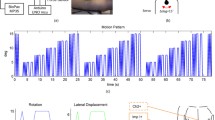Abstract
In the recording of biomedical signals, a significant noise component is introduced by the electrode. The magnitude of this noise is considerably higher than the equivalent thermal noise from the electrode impedance. As the noise in surface electrodes limits the resolution of biopotential recordings, it is important to understand its origin. It was found that the noise mainly originates in the electrolyte-skin interface and that it is highly dependent on the electrode gel used and the skin properties of the test subject. Depending on skin treatment, magnitudes between 1 and 20μVrms were measured among subjects. When the metal-electrolyte interface was allowed time to stabilise, electrodes of different metals measured face to face all showed a negligibly small noise magnitude (<1μVrms). In pre-gelled electrodes, where the metal-electrolyte interface has stabilised, no difference in noise properties was found between Ag−AgCl electrodes and other metals when measured on the skin. In subjects at rest, the contribution of EMG signals to the total noise level was shown to be negligibly small compared with the noise contribution of the electrolyte-skin interface. The magnitude of the noise of electrodes appeared to be inversely proportional to the square root of the area of the electrode on the skin.
Similar content being viewed by others
References
Carim, H. M. (1988): ‘Bioelectrodes’ inWebster, J. G. (Ed.): ‘Encyclopedia of medical devices and instrumentation’ (John Wiley and Sons, New York, 1988), pp. 195–226
Eggins, B. R. (1993): ‘Skin contact electrodes for medical applications’,Analist.,188, pp. 439–442
Fernández, M., andPallás-Areny, R. (2000): ‘Ag−AgCl electrode noise in high-resolution ECG measurements’,Biomed. Instrum. Technol.,34, pp. 125–130
Flasterstein, A. H. (1966): ‘Voltage fluctuations of metal-electrolyte interfaces’,Med. Biol. Eng.,4, pp. 583–588
Geddes, L. A. (1972): ‘Electrodes and the measurement of bioelectric events’ (Wiley-Interscience, New York, 1972)
Geddes, L. A., andBaker, L. E. (1975): ‘Principles of applied biomedical instrumentation’ (Wiley-Interscience, New York, 1975)
Godin, D. T., Parker, P. A., andScott, R. N. (1991): ‘Noise characteristics of stainless-steel surface electrodes’,Med. Biol. Eng. Comput.,29, pp. 585–590
Gondran, C., Siebert, E., Yacoub, S., andNovakov, E. (1995): ‘Dry electrode based on NASICON ceramic for surface biopotential measurement—skin-electrode impedance and noise’,Innov. Tech. Biol. Med.,16, pp. 113–118
Gondran, C., Siebert, E., Yacoub, S., andNovakov, E. (1996): ‘Noise of surface bio-potential electrodes based on NASICON ceramic and Ag−AgCl’,Med. Biol. Eng. Comput.,34, pp. 460–466
Grimbergen, C. A., Metting van Rijn, A. C., andPeper, A. (1993): ‘A method for the measurement of the properties of individual electrode-skin interfaces and the implications of the electrode properties for the amplifier’. Proceedings of the 14th Annual International Conference of IEEE Engineering in Medicine & Biological Society, Paris, France,14, pp. 2382–2383
Huta, J. G., andWebster, J. G. (1973): ‘60-Hz interference in electro-cardiography’,IEEE Trans. Biomed. Eng.,20, pp. 91–101
Klinger, D. R., Booth, H. E., andSchoenberg, A. A. (1979): ‘Effects of dc bias currents on ECG electrodes’,Med. Instrum.,13, pp. 257–258
McAdams, E. T., andJossinet, J. (1991): ‘The importance of electrode-skin impedance in high resolution electrocardiography’,Automedica,13, pp. 187–208
McAdams, E. T., Jossinet, J., Lackermeier, A., andRisacher, F. (1996): ‘Factors affecting electrode-gel-skin interface impedance in electrical impedance tomography’,Med. Biol. Eng. Comput.,34, pp. 397–408
Metting van Rijn, A. C., Peper, A., andGrimbergen, C. A. (1990): ‘High-quality recording of bioelectric events. Part 1: Interference reduction, theory and practice’,Med. Biol. Eng. Comput. 28, pp. 389–397
Metting van Rijn, A. C., Peper, A., andGrimbergen, C. A. (1991): ‘High-quality recording of bioelectric events. Part 2: Low-noise, low-power multichannel amplifier design’,Med. Biol. Eng. Comput.,29, pp. 433–440
Rosell, J., Colominas, J., Riu, P., Pallás-Areny, R., andWebster, J. G. (1988): ‘Skin impedance from 1 Hz to 1 MHz’,IEEE Trans. Biomed. Eng.,35, pp. 649–651
Schwan, H. P. (1992): ‘Linear and nonlinear electrode polarization and biological materials’,Ann. Biomed. Eng.,20, pp. 269–288
Searle, A., andKirkup, L. (1999): ‘Real time impedance plots with arbitrary frequency components’,Physiol. Meas.,20, pp. 103–114
Author information
Authors and Affiliations
Corresponding author
Rights and permissions
About this article
Cite this article
Huigen, E., Peper, A. & Grimbergen, C.A. Investigation into the origin of the noise of surface electrodes. Med. Biol. Eng. Comput. 40, 332–338 (2002). https://doi.org/10.1007/BF02344216
Received:
Accepted:
Issue Date:
DOI: https://doi.org/10.1007/BF02344216




